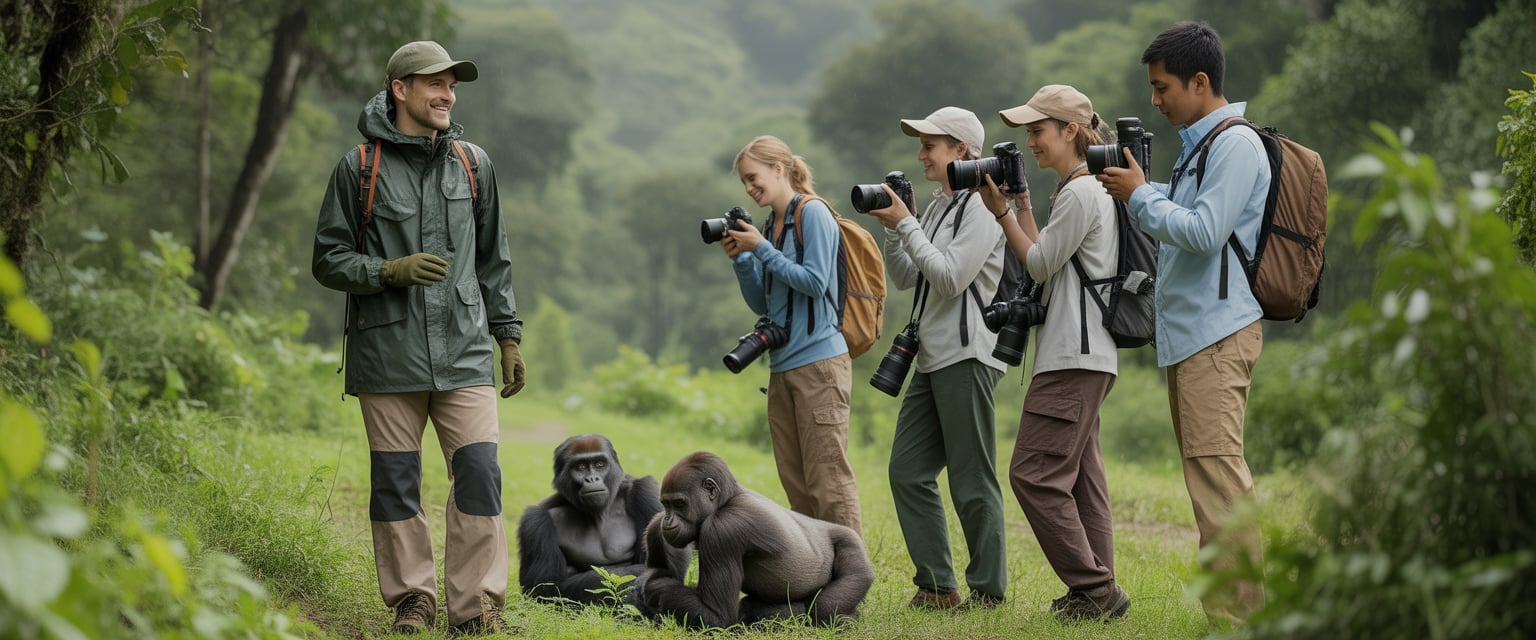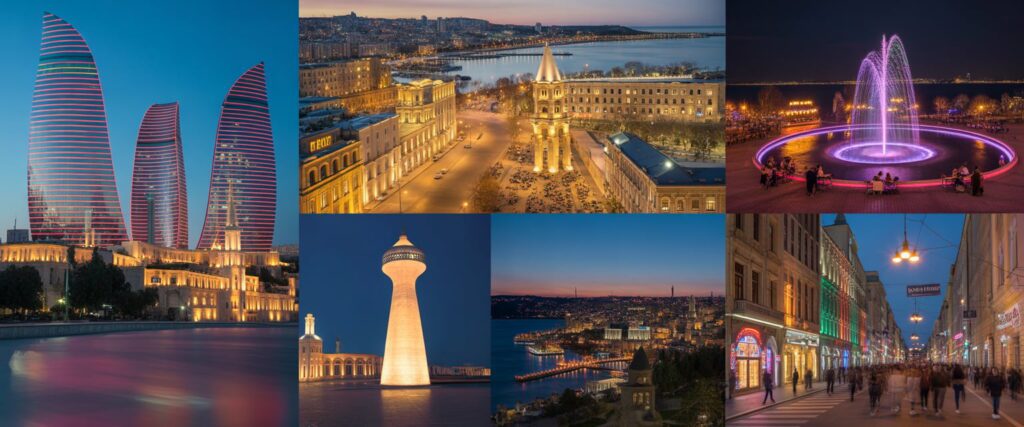If you’re dreaming of coming face-to-face with the majestic mountain gorillas, this guide to the Top 10 Best Gorilla Trekking Tours in Rwanda & Uganda is your perfect starting point. These two East African gems offer the most immersive wildlife adventures on the continent, combining raw nature, conservation, and luxury.
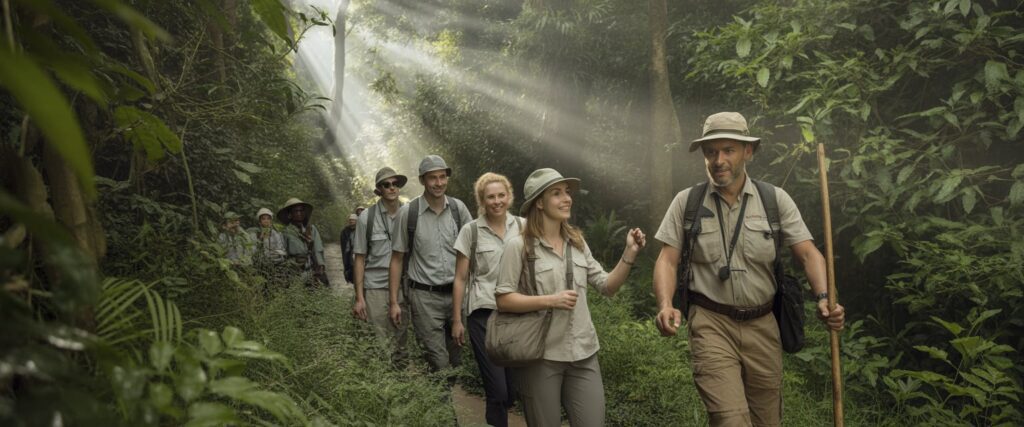
From the mist-covered slopes of Volcanoes National Park in Rwanda to the dense jungles of Bwindi Impenetrable National Park in Uganda, travelers can witness one of the world’s rarest species in its natural home. Whether you seek luxury or adventure, the Top 10 Best Gorilla Trekking Tours in Rwanda & Uganda promise unforgettable encounters, sustainable tourism, and an authentic connection with Africa’s untamed beauty.
Table of Contents
Top 10 Best Gorilla Trekking Tours in Rwanda & Uganda
Gorilla trekking in Rwanda and Uganda offers one of Africa’s most remarkable wildlife experiences. These two countries protect the last remaining mountain gorillas in their natural forest homes, drawing travelers from around the world to Volcanoes National Park in Rwanda and Bwindi Impenetrable National Park in Uganda. The best gorilla trekking tours in Rwanda and Uganda provide safe, guided encounters with these endangered primates while supporting vital conservation efforts.
Each destination offers something unique. Rwanda’s Volcanoes National Park is known for its easy access from Kigali and luxury lodges, ideal for those seeking a high-end experience such as a luxury Rwanda gorilla safari. Uganda, on the other hand, offers a more diverse adventure through forested terrain in Bwindi and Mgahinga, often combined with a Uganda safari gorilla experience that includes other wildlife encounters.
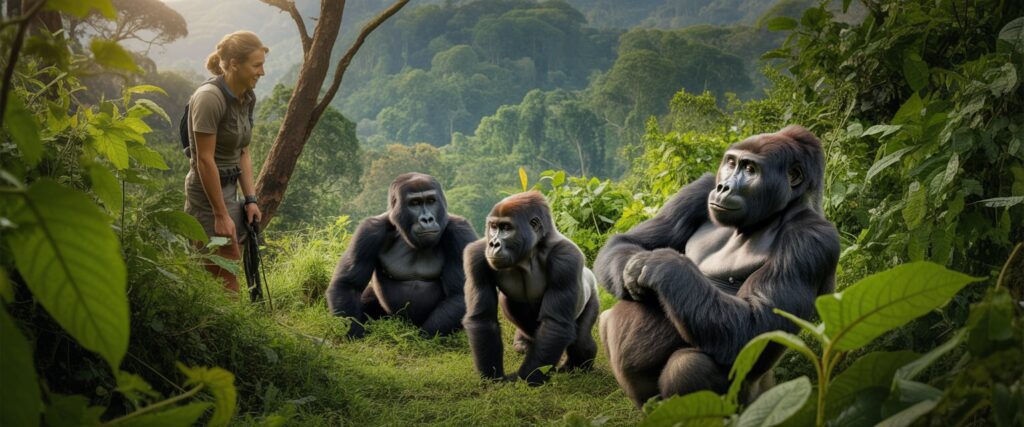
Choosing between Rwanda and Uganda depends on travel style, budget, and time. Rwanda’s treks are shorter and more accessible, while Uganda’s longer hikes provide a deeper immersion in nature. Both countries deliver unforgettable moments with mountain gorillas and form the heart of an authentic Africa safari and gorilla trekking journey.
Travelers seeking close encounters with mountain gorillas often choose Rwanda and Uganda for their rich biodiversity, safe trekking routes, and experienced guides. Both countries offer well-organized tours that range from budget-friendly treks to luxury safaris with conservation-focused experiences.
Best Rwanda Gorilla Trekking Packages
Rwanda’s Volcanoes National Park offers some of the most accessible and organized gorilla trekking routes in Africa. The park hosts several habituated gorilla families, making sightings highly likely. Many tours begin in Kigali, just a few hours from the park, allowing for short 2–3-day trips.
Luxury travelers often book with Volcanoes Safaris or Amahoro Tours, known for eco-friendly lodges and community partnerships. Packages usually include transport, permits, guides, and accommodation.
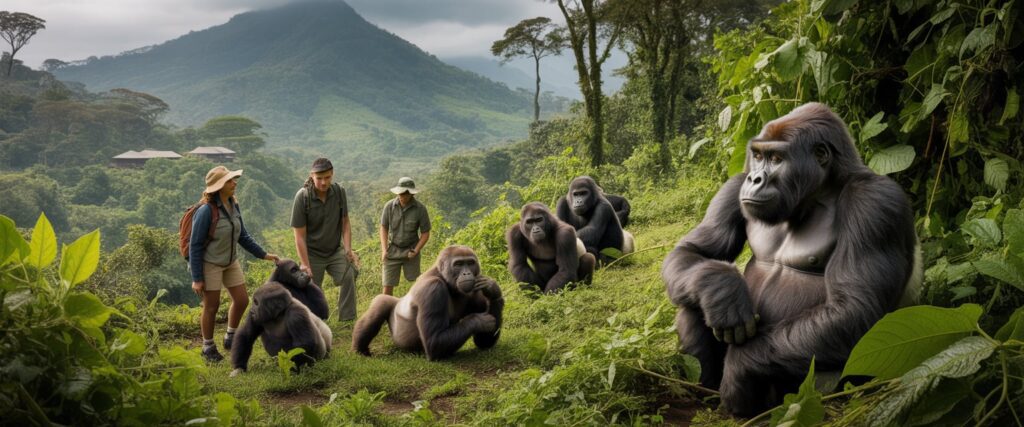
A typical Rwanda gorilla trekking permit costs about $1,500 per person, set by the Rwanda Development Board. Tours often combine gorilla trekking with visits to cultural villages or golden monkey tracking. For a list of top-rated companies, see the best gorilla trekking companies in Rwanda.
Top Uganda Gorilla Safari Experiences
Uganda’s Bwindi Impenetrable National Park and Mgahinga Gorilla National Park host over half of the world’s mountain gorillas. Treks here are longer and more rugged than in Rwanda, offering a deeper forest experience.
Many visitors combine gorilla trekking with chimpanzee tracking in Kibale or wildlife safaris in Queen Elizabeth National Park. Popular operators such as Wild Whispers Africa, Tranquil Safaris, and Insight Safari Holidays tailor itineraries to different budgets.
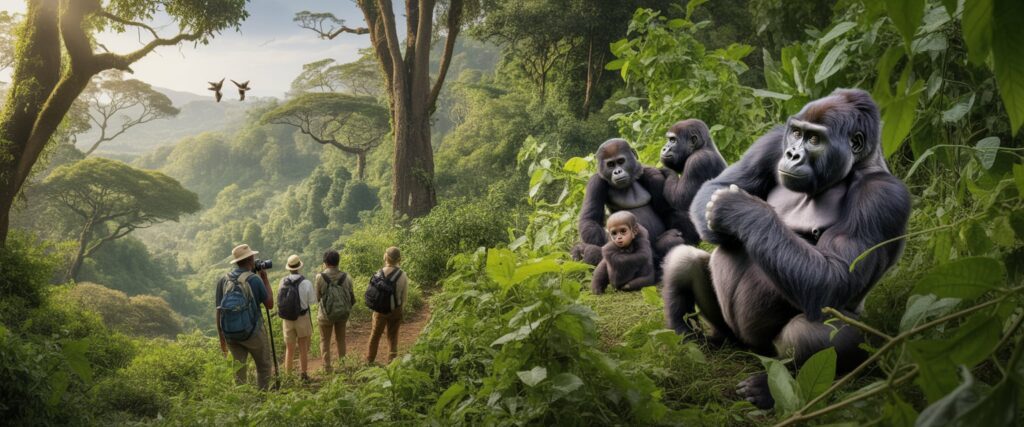
Uganda’s trekking permits cost $700, making it more affordable than Rwanda. Multi-day safaris often include cultural visits, game drives, and birdwatching. More details on leading operators can be found through top Uganda gorilla safari companies.
Combined Rwanda & Uganda Gorilla Safaris
Some tours offer cross-border itineraries that include both Volcanoes National Park in Rwanda and Bwindi or Mgahinga in Uganda. These combined safaris maximize the chance to see multiple gorilla families while experiencing two distinct landscapes.
Travelers often start in Kigali due to its proximity to the Ugandan border. Packages may include cultural tours, game drives, and optional extensions to Queen Elizabeth National Park or Lake Bunyonyi.
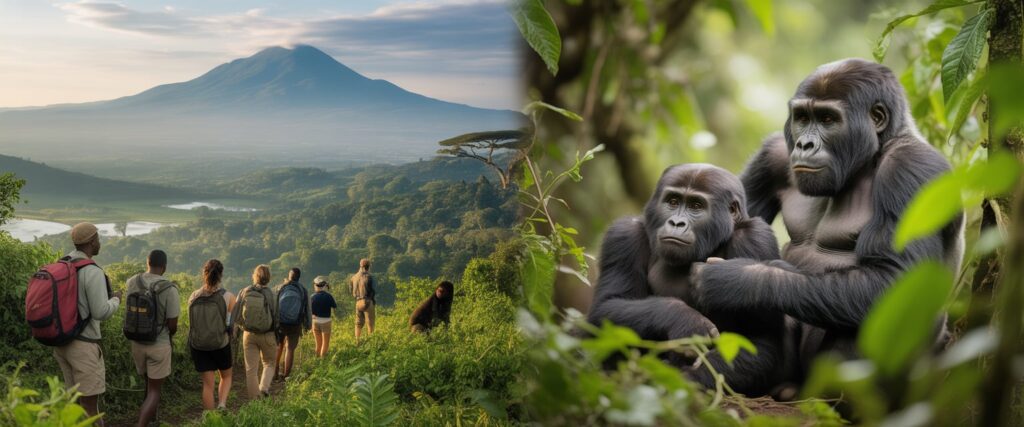
Operators like Nextgen Safaris and Greenway Nature Tours organize combined gorilla trekking tours that handle both permits and border logistics. These tours are ideal for travelers seeking variety and efficient travel between destinations.
Recommended Gorilla Trekking Companies
Choosing the right operator ensures safety, comfort, and ethical practices. In Rwanda, Volcanoes Safaris, Amahoro Tours, and Primate Safaris Rwanda stand out for their experienced guides and sustainable tourism models.
In Uganda, Wild Whispers Africa, Tranquil Safaris, and Gorilla Tours Uganda are recognized for reliable service and knowledgeable staff. Each company assists with permits, transport, and accommodation.
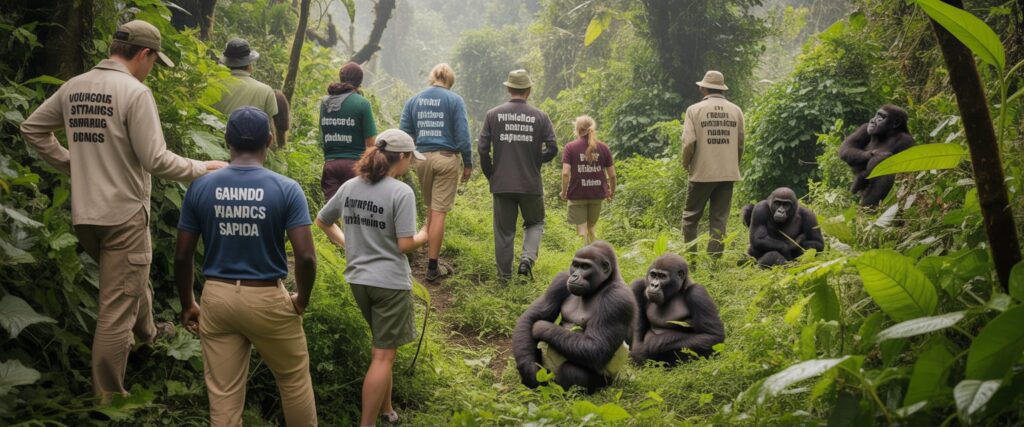
When comparing the best gorilla trekking company in Rwanda or Uganda, travelers should review customer feedback, conservation practices, and included services. For verified listings, see the top gorilla safari companies in Uganda and Rwanda.
Gorilla Trekking Destinations and Habitats
Mountain gorillas live in only a few protected regions of central and eastern Africa. These rare primates thrive in misty, high-altitude forests that span Rwanda, Uganda, and parts of the Democratic Republic of Congo. Each habitat offers distinct terrain, accessibility, and trekking experiences.
Volcanoes National Park in Rwanda
Volcanoes National Park lies in northwestern Rwanda and forms part of the Virunga Mountains. It is home to around one-third of the world’s remaining mountain gorillas. The park’s dense bamboo and montane forests provide ideal conditions for several habituated gorilla families open to visitors.
Trekkers can reach the park easily from Kigali, with a drive of about 2.5 hours. This accessibility makes it a top choice for short Rwanda gorilla treks and luxury safaris. The park’s terrain includes five volcanoes—Karisimbi, Bisoke, Muhabura, Gahinga, and Sabyinyo—offering scenic backdrops during the trek.
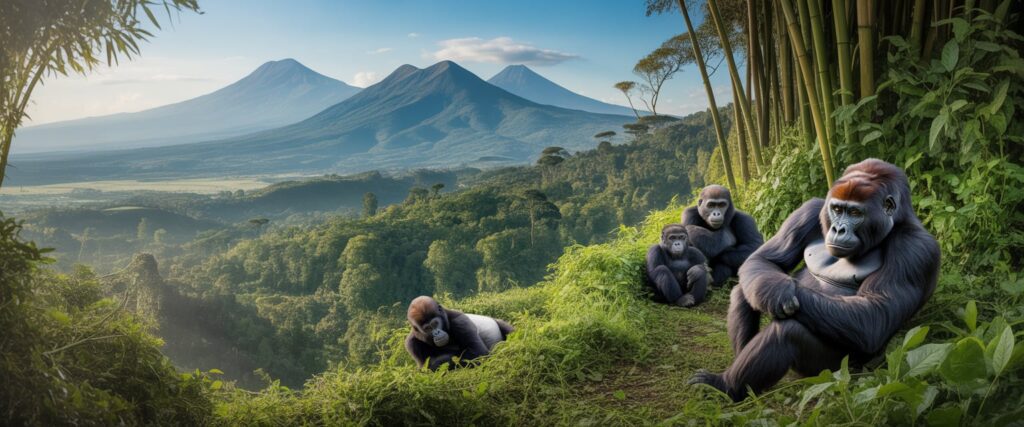
Visitors often combine gorilla trekking with cultural visits to nearby communities or the Dian Fossey Research Center. More details on trekking experiences and permits can be found at TourRadar’s guide to gorilla trekking.
Bwindi Impenetrable Forest National Park
Located in southwestern Uganda, Bwindi Impenetrable Forest National Park is one of the most biologically diverse areas in Africa. It protects about half of all mountain gorillas on Earth. The forest’s steep ridges and thick vegetation create a challenging but rewarding trekking experience.
Bwindi has over 20 habituated gorilla families spread across four main sectors: Buhoma, Ruhija, Rushaga, and Nkuringo. Trekkers can choose routes based on fitness level and travel time. The park also supports rich birdlife and other primates, making it ideal for those seeking a full wildlife experience.
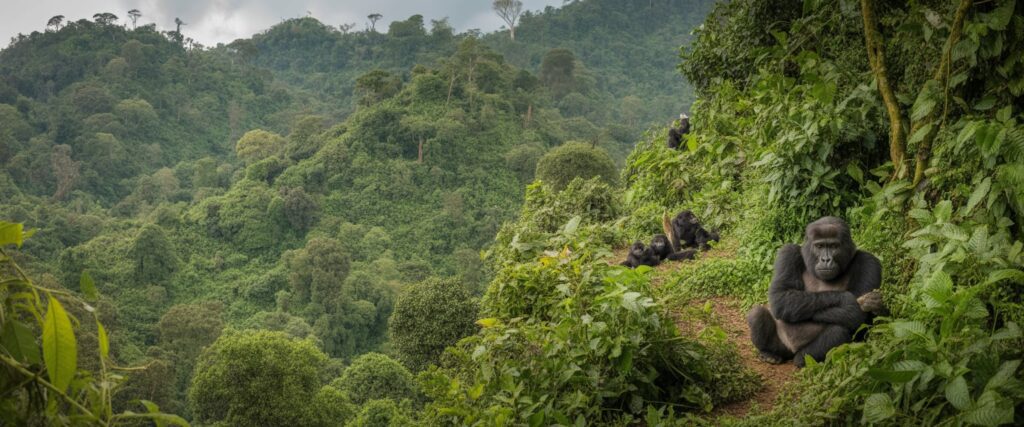
Gorilla permits in Uganda cost around $800 and include guides and park entry. Visitors can explore affordable and luxury options through Nextgen Safaris’ Uganda gorilla tours.
Mgahinga Gorilla National Park
Mgahinga Gorilla National Park, also in Uganda, sits on the slopes of the Virunga Volcanoes near the borders with Rwanda and Congo. Though smaller than Bwindi, it offers a quieter and more intimate trekking experience. The park is home to the Nyakagezi gorilla family, known for its stable and friendly nature toward visitors.
The park’s altitude ranges from 2,200 to 4,100 meters, creating a cool climate with lush vegetation. Trekkers can also hike the volcanoes or spot golden monkeys, another rare species found here. Mgahinga is ideal for travelers who want fewer crowds and panoramic views of the Virunga range.
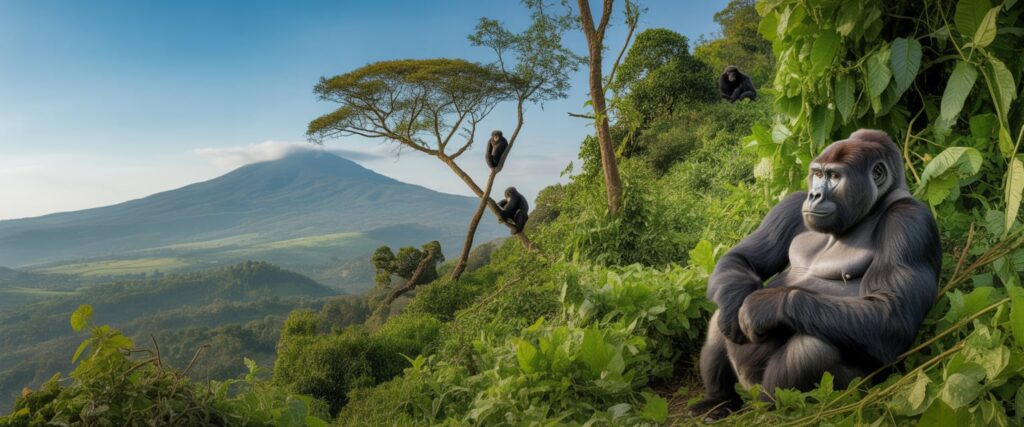
Access from Kisoro town is straightforward, and the park connects easily with Kigali–Uganda cross-border safaris. More information is available at Bwindi Gorilla Tours.
Other Gorilla Trekking Locations in Africa
Beyond Rwanda and Uganda, gorilla trekking extends into the Democratic Republic of Congo and Gabon. In Congo, Virunga National Park shelters mountain gorillas, while Kahuzi-Biega National Park protects the larger eastern lowland gorillas. These parks offer more remote and adventurous experiences but require careful planning due to security and infrastructure challenges.
Gabon provides opportunities for lowland gorilla trekking in places like Loango National Park, where gorillas live alongside elephants and hippos. While less developed for tourism, it appeals to travelers seeking rare encounters in pristine rainforest settings.
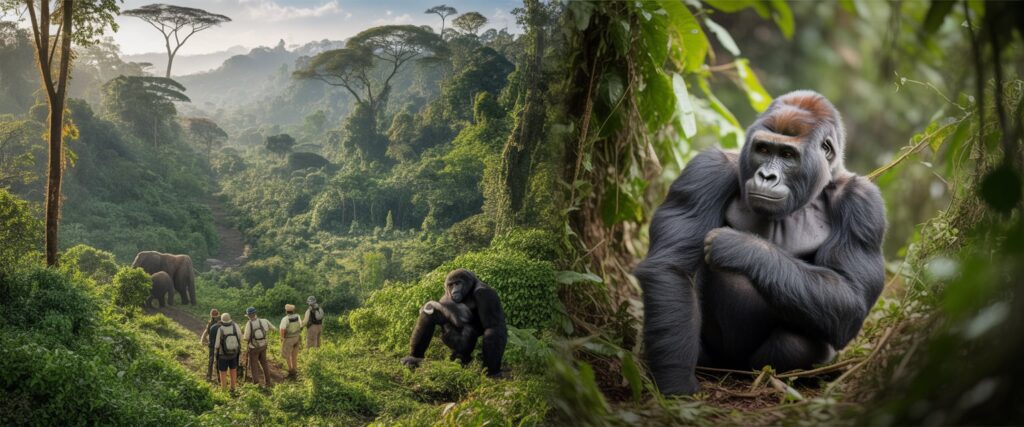
Each destination contributes to gorilla conservation and sustainable tourism across Central Africa. Visitors choosing between these areas should consider permit costs, accessibility, and personal comfort when planning their gorilla holidays in Africa.
Comparing Gorilla Trekking in Rwanda vs Uganda
Rwanda and Uganda both offer close encounters with mountain gorillas, but they differ in terrain, cost, and accessibility. Rwanda provides easier access and shorter treks, while Uganda offers denser forests and more varied safari experiences.
Gorilla Trekking Experience Differences
In Rwanda, Volcanoes National Park features open bamboo forests that make gorilla viewing easier. Trekkers often reach the gorilla families within one to two hours. The experience suits travelers seeking a shorter, less strenuous hike.
Uganda’s Bwindi Impenetrable National Park provides a tougher but more immersive adventure. The dense rainforest requires longer hikes, sometimes lasting up to six hours. Visitors often describe it as a deeper wilderness experience.
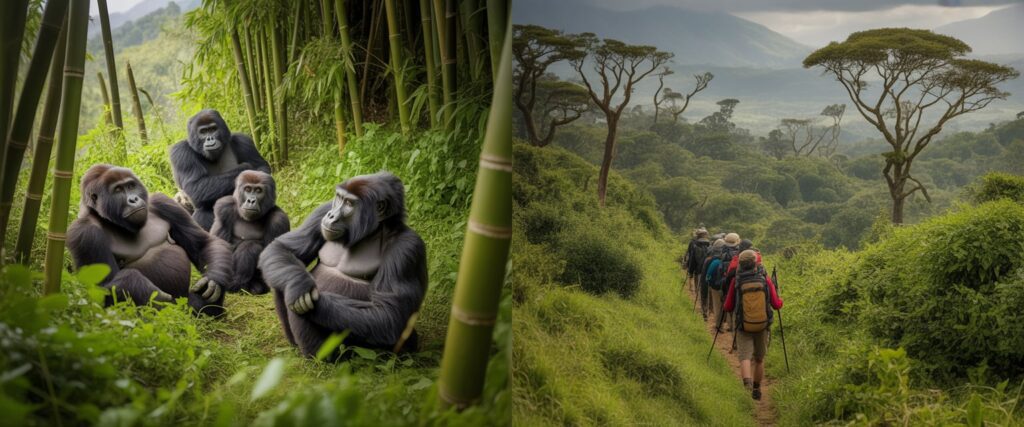
Permit prices also vary. Rwanda charges about US$1,500, while Uganda’s permits cost US$800 for foreign visitors, according to SafariBookings. Both countries strictly limit daily permits to protect the gorillas.
Uganda’s treks often combine with other wildlife safaris, such as chimpanzee tracking or savannah tours in Queen Elizabeth National Park. Rwanda’s treks pair well with a luxury Rwanda gorilla safari or short Rwanda safari holidays.
Accessibility and Travel Logistics
Rwanda offers the most convenient access. The drive from Kigali to Volcanoes National Park takes about three hours on paved roads. This makes it ideal for travelers with limited time or those starting from nearby Kenya or Tanzania.
Uganda’s Bwindi requires a longer journey—about eight to ten hours from Entebbe—though domestic flights shorten travel time. The park has several trailheads, each leading to different gorilla groups.
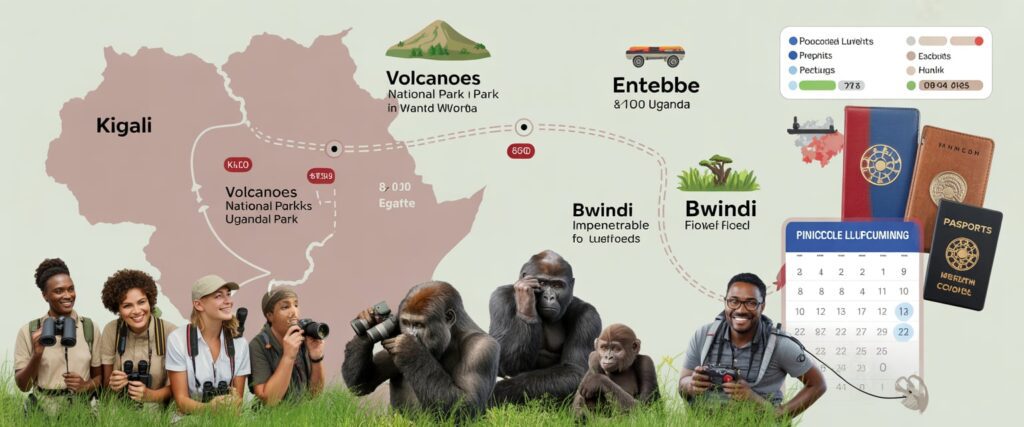
Those planning multi-country safaris often combine Kigali and Uganda routes, entering through Rwanda and trekking in Uganda for lower permit costs. Uganda vs Rwanda Gorilla Trekking explains that Rwanda’s single entry point simplifies logistics, while Uganda’s multiple sectors allow flexibility for tour operators.
Luxury vs Budget Safari Options
Rwanda focuses on high-end tourism. Lodges near Volcanoes National Park, such as Bisate and Sabyinyo, cater to luxury Rwanda gorilla safari travelers. Prices reflect exclusivity, comfort, and proximity to the park.
Uganda provides a wider range, from budget Uganda safari lodges to mid-range and luxury options. Bwindi’s accommodations often sit within or near the forest, giving a more secluded feel.
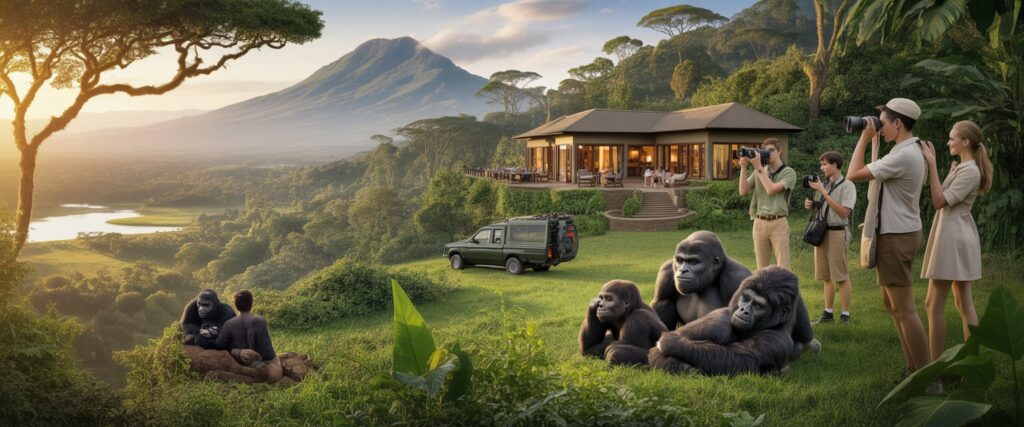
Travelers seeking gorilla trekking Uganda experiences often combine them with game drives or lake retreats, offering better value for extended stays. Rwanda’s focus on premium service suits those prioritizing comfort and short travel times.
Both destinations deliver unforgettable encounters, but the choice depends on cost, travel time, and preferred level of comfort.
Gorilla Trekking Permits, Costs, and Planning
Travelers planning a gorilla trekking safari in Rwanda or Uganda should understand the permit system, seasonal differences, and what each safari package includes. These details affect both the total cost and the quality of the experience.
Gorilla Permit Prices and Booking
A gorilla permit is mandatory for every trek. In Rwanda, the permit costs $1,500 per person for foreign visitors, while in Uganda it costs $700. These fees include park entry, guides, and one hour with a habituated gorilla family.
Permits are limited to protect the gorillas, so travelers should book several months in advance. Many tour operators handle this process. Companies such as Nextgen Safaris and Nkuringo Safaris organize permits as part of their packages, saving visitors time and ensuring correct registration.
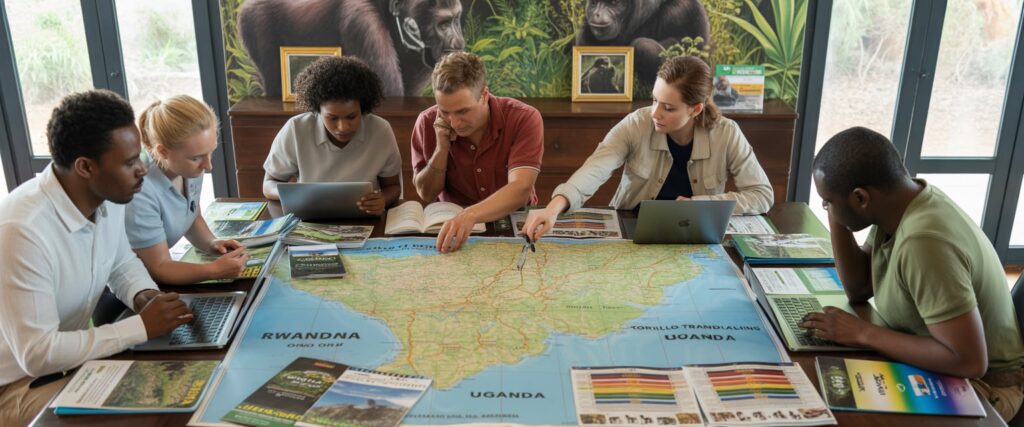
Rwanda’s higher price reflects its focus on low-impact, high-value tourism and strong conservation funding. Uganda’s lower cost attracts more budget-conscious travelers seeking a similar experience in Bwindi Impenetrable Forest or Mgahinga Gorilla National Park.
Best Season for Gorilla Trekking
Both Rwanda and Uganda offer year-round trekking, but the dry seasons—June to September and December to February—provide the best conditions. Trails are less muddy, and visibility improves for photography.
The wet seasons from March to May and October to November bring fewer tourists and lower safari Rwanda prices, which can benefit travelers seeking quieter experiences. Some operators even offer discounted Rwanda gorillas price or accommodation deals during these months.
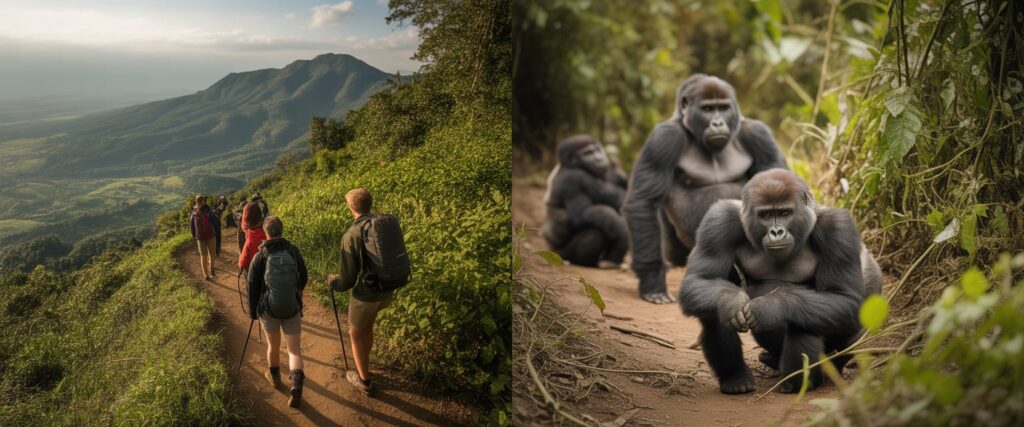
Weather can vary by region. Volcanoes National Park in Rwanda and Bwindi in Uganda both have cool mountain climates, so trekkers should pack waterproof gear and layers.
Safari Packages and Inclusions
Rwanda safari packages and Uganda gorilla trekking safari options range from short one-day trips to week-long tours that combine gorilla encounters with cultural or wildlife experiences.
Typical inclusions:
- Gorilla permit
- Accommodation and meals (budget to luxury lodges)
- Private transport and driver-guide
- Park entry fees
- Optional activities like golden monkey tracking or cultural visits
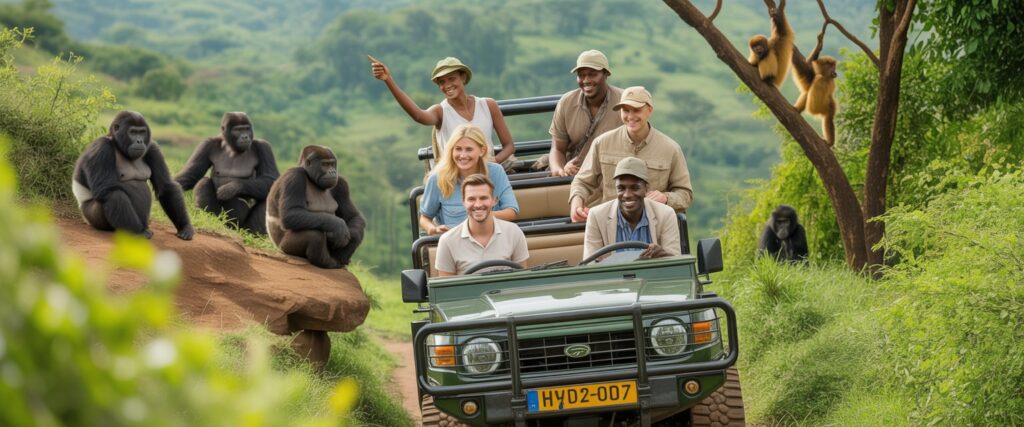
Prices vary widely. A mid-range 3-day Rwanda gorilla trek averages $2,200–$2,500 per person, while luxury safaris can exceed $5,000. Uganda offers more affordable itineraries around $1,500–$2,000 depending on lodge level and group size.
Travelers comparing Rwanda safari cost and Uganda gorilla holidays often balance comfort, accessibility, and price to find the best value for their adventure.
Preparing for Your Gorilla Trekking Adventure
Travelers heading to Rwanda or Uganda for a gorilla trekking experience should plan carefully to stay safe and comfortable. The terrain is steep and humid, and the treks can last several hours. Proper fitness, gear, and respect for conservation rules make the journey rewarding and responsible.
Physical Fitness and Trekking Difficulty
Gorilla trekking involves hiking through dense forests, steep slopes, and muddy ground. Trekkers may walk anywhere from one to eight hours depending on the gorilla family’s location. The activity requires moderate physical fitness but not expert-level hiking skills.
Regular walking, stair climbing, or light hiking before the trip helps build stamina. Those planning longer treks or gorilla habituation experiences should focus on endurance and leg strength.
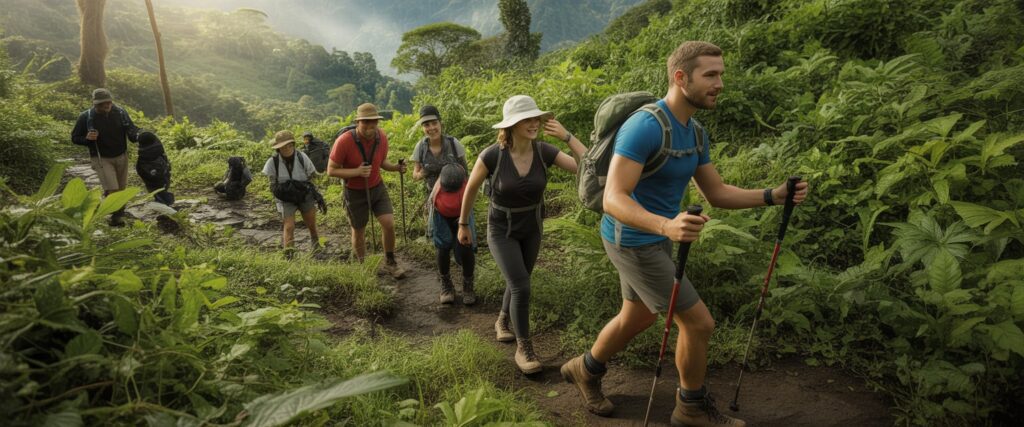
Altitude can also affect breathing, especially in areas like Rwanda’s Volcanoes National Park or Uganda’s Bwindi Impenetrable Forest. Arriving a day early allows trekkers to adjust. For travelers with mobility concerns, some parks offer porters or sedan chairs for support.
Essential Packing List and Gear
Packing the right gear ensures comfort and safety throughout the trek. The region’s weather is unpredictable, so waterproof and durable clothing is essential.
Recommended items include:
- Sturdy hiking boots: Waterproof boots with ankle support help on slippery and uneven trails.
- Lightweight long-sleeve shirts and pants: Protect against insects and thorny plants.
- Rain jacket or poncho: Sudden rain showers are common near the equator, as noted by Rwanda Gorilla Safaris.
- Gloves: Useful when grabbing vines or branches for balance.
- Insect repellent and sunscreen: Essential for tropical conditions.
- Reusable water bottle and snacks: Staying hydrated and energized is key.
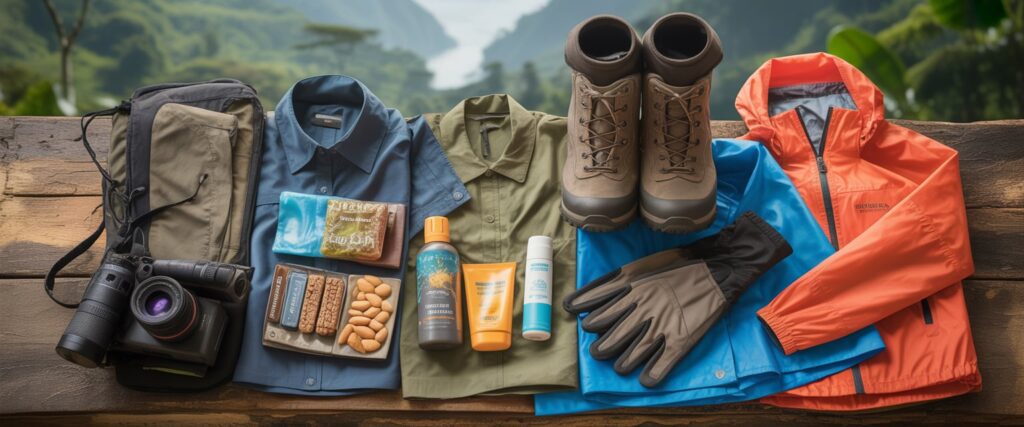
A camera with a zoom lens allows photos from a safe distance without disturbing the gorillas.
Safety, Rules, and Conservation Guidelines
Gorilla trekking follows strict rules to protect both visitors and wildlife. Trekkers must keep at least seven meters from gorillas to prevent disease transmission. Flash photography is not allowed, and guides enforce quiet observation to avoid stress to the animals.
Only one hour is permitted with each gorilla group to minimize disturbance. Participants should follow all guide instructions and avoid direct eye contact or sudden movements.
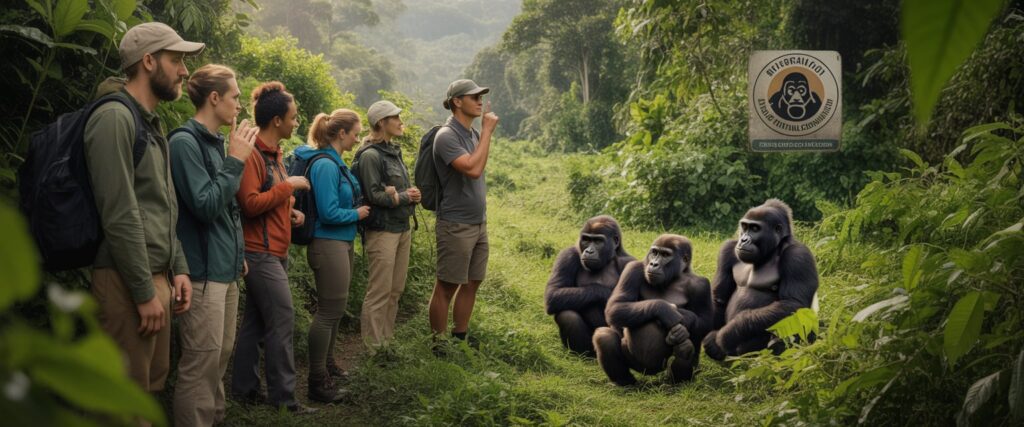
Permit fees support conservation and local communities, helping protect endangered gorillas and fund nearby schools and health projects. Choosing licensed operators such as those listed by Trek Gorilla Safaris ensures compliance with park regulations and ethical tourism standards.
Respecting these rules helps sustain gorilla populations and supports broader conservation efforts that also protect species like chimpanzees.
Gorilla Conservation and Responsible Tourism
Gorilla trekking in Rwanda and Uganda plays a major role in protecting endangered mountain gorillas and improving local livelihoods. Carefully managed tourism in parks like Bwindi Impenetrable National Park and Volcanoes National Park helps fund conservation programs, supports rangers, and creates jobs for nearby communities.
Impact of Gorilla Tourism on Conservation
Tourism revenue funds essential protection for mountain gorillas and their habitats. Each visitor must buy a permit, which helps pay for park operations, anti-poaching patrols, and veterinary care. In Uganda, a permit costs between $700–800 USD and covers park entry and expert guides who track habituated gorilla families (TourRadar).
Strict rules limit contact time and group size to reduce stress on gorillas. Only a few groups are allowed to visit each family daily. This regulation ensures sustainable tourism while maintaining natural behavior patterns.
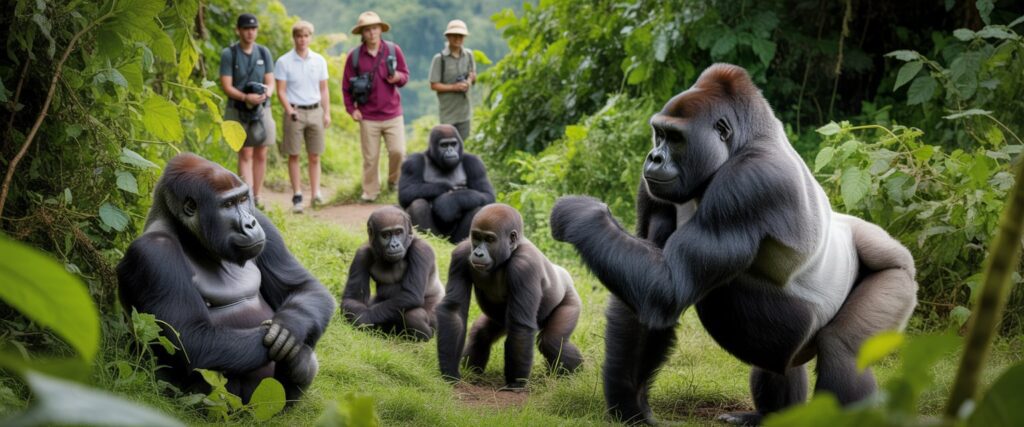
Programs like gorilla habituation in Bwindi Impenetrable National Park allow researchers and small groups to spend extended time observing gorillas under controlled conditions. These efforts have helped increase the population to over 1,000 individuals across Uganda, Rwanda, and Congo (Intrepid Travel).
Supporting Local Communities
Gorilla tourism directly benefits nearby villages through revenue-sharing programs and employment. Local residents work as guides, porters, and lodge staff, gaining stable income while learning conservation skills.
A portion of permit fees funds community projects such as schools, health clinics, and clean water systems. These initiatives encourage residents to protect wildlife instead of turning to activities like poaching or deforestation.
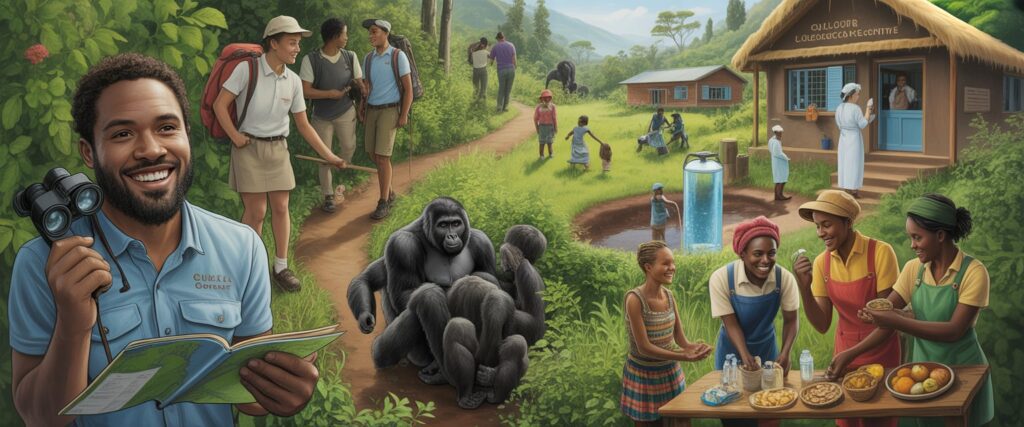
Many Rwanda gorilla safari companies partner with cooperatives to sell local crafts and food products. This approach builds stronger ties between conservation and economic growth, ensuring that protecting gorillas also improves human well-being.
Conclusion
Choosing from the Top 10 Best Gorilla Trekking Tours in Rwanda & Uganda ensures you’ll experience the thrill of observing mountain gorillas responsibly while supporting vital conservation efforts. Both Rwanda and Uganda provide world-class trekking routes, expert guides, and unforgettable landscapes that blend adventure with purpose. Whether you opt for Rwanda’s luxurious, accessible safaris or Uganda’s rugged, immersive forest treks, each journey offers a once-in-a-lifetime opportunity to connect with nature at its purest. Embark on your safari today and discover why the Top 10 Best Gorilla Trekking Tours in Rwanda & Uganda remain Africa’s ultimate adventure.
Frequently Asked Questions
Which month is best for gorilla trekking in Uganda?
The best months for gorilla trekking in Uganda are June to September and December to February, during the dry seasons. Trails are less muddy, making the trek easier and photography clearer.
Is gorilla trekking better in Uganda or Rwanda?
Both countries offer incredible experiences, but Uganda is known for longer, more adventurous treks, while Rwanda provides easier access and well-organized tours. Rwanda’s Volcanoes National Park is perfect for comfort travelers; Uganda’s Bwindi suits adventurers.
What is the best gorilla family to see in Rwanda?
The Sabyinyo and Amahoro groups in Volcanoes National Park are often considered the best to visit. They are known for calm behavior, accessibility, and rich family interactions ideal for first-time trekkers.
What is the best time of year to see gorillas in Rwanda?
The dry seasons from June to September and December to February are ideal for gorilla trekking in Rwanda. Trails are more manageable, and visibility in the forest is much better during these months.
How much does it cost to trek with gorillas in Rwanda?
A gorilla trekking permit in Rwanda costs around $1,500 per person. This fee includes the guided trek, one hour with the gorillas, and conservation contributions that support local communities.
How difficult is gorilla trekking in Rwanda?
The trek is moderately challenging, depending on your fitness and the gorilla group’s location. Expect hikes through uneven terrain and thick forest lasting 2–6 hours, but porters and guides make the journey manageable for most visitors.
Is the gorilla trek worth it?
Absolutely. Seeing mountain gorillas in their natural habitat is a once-in-a-lifetime wildlife encounter. The emotional connection, scenic landscapes, and conservation impact make the experience unforgettable.
How much does it cost to see a gorilla in Rwanda?
The total cost typically ranges from $1,700 to $2,500, including the $1,500 permit, park fees, transport, and accommodation. Luxury lodges or private tours may increase the price.
Is gorilla trekking worth it in Rwanda?
Yes. Rwanda’s gorilla trekking is well-organized, safe, and deeply rewarding. The country’s conservation efforts and scenic Volcanoes National Park offer one of the world’s most ethical and memorable wildlife experiences.
Where to visit gorillas in Rwanda?
You can see gorillas in Volcanoes National Park, located in Rwanda’s northwest. The park protects several habituated gorilla families and offers stunning views of the Virunga Mountains.
How many days do you need for gorilla trekking in Rwanda?
A 3-day trip is ideal — one day for arrival, one for trekking, and one for relaxation or cultural experiences. Travelers seeking more adventure often extend to 4–5 days to explore nearby lakes and villages.
What fitness level is gorilla trekking Rwanda?
You need a moderate level of fitness. While you don’t need to be an athlete, regular walking, hiking, or stair climbing helps prepare for the steep and humid conditions in the forest.
What is the best time to see the gorillas in Rwanda?
The best time is during the dry months (June–September, December–February) when the trails are firm, visibility is high, and gorillas are easier to locate.
Which month is best to visit Rwanda?
July and August are the most popular months to visit Rwanda. The weather is dry and pleasant, making it perfect not only for gorilla trekking but also for exploring Kigali, Lake Kivu, and national parks.
What’s the best month to see gorillas in the wild?
June, July, and August are considered the best months to see gorillas in the wild. These months offer clear skies, dry trails, and comfortable temperatures for trekking.
What temperature is good for gorilla trekking?
Ideal temperatures range between 15°C to 25°C (59°F–77°F). This mild climate keeps trekking comfortable and supports the lush vegetation that gorillas depend on year-round.
